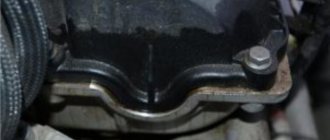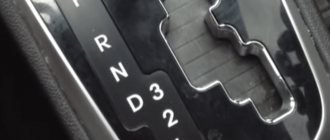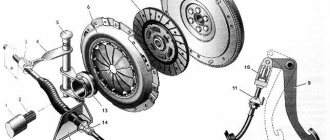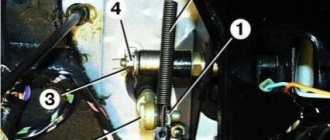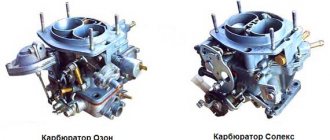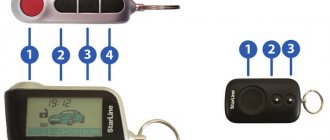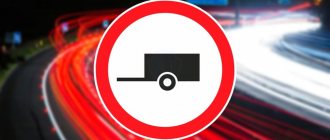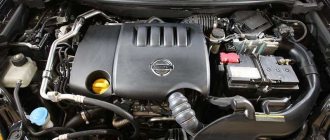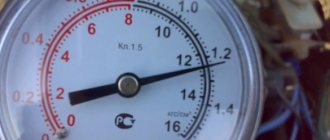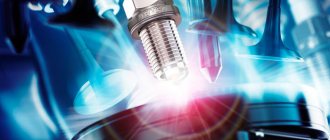The term engine braking means slowing down a vehicle without pressing the brake pedal. Some people use this method of stopping the car to save fuel, while others protect the life of the brake pads.
However, according to experts, such braking comes to the rescue during a skid when driving on a slippery road or in mountainous areas, and it can also save lives if problems arise with the brakes. Be that as it may, this phenomenon has both pros and cons, and we will talk about them today.
What is engine braking
A common expression characterizes reducing the speed of a vehicle by releasing the gas pedal when the gear is engaged. This method of braking is also called forced idling.
To better understand the process, we will show everything using a simple example. A car moving, for example, in 3rd gear, approaches a traffic light. Its driver, seeing that the red light is about to turn on, takes his foot off the accelerator pedal, which is why the vehicle begins to move by inertia and its speed decreases. As a result, before a traffic light, the driver can only lightly press the brake pedal to stop the car. It turns out that the braking process is due to a gradual reduction in gear and a decrease in engine speed.
Here is another example, as they say, “on the fingers”: while driving in urban conditions, where there is a dense flow of cars, the driver engages first gear, and the car moves off. After pressing the gas pedal, the TZ accelerates more strongly, then the driver takes his foot off the accelerator - the car immediately slows down, but this happens not thanks to the brakes, but precisely due to the engine. Engine braking occurs.
Many people mistakenly believe that the slowdown in this case is due to the process of friction. An exception to this rule is diesel power plants, which do not have a throttle valve. In gasoline engines, the speed decreases due to the blocking of fuel injection. The driver stops pressing the gas pedal, the supply of gasoline to the engine stops, which means it no longer transfers its energy to the transmission.
The reduction in speed occurs due to the resistance of inertia, which tries to increase the rotation of the crankshaft. The revolutions drop, a radically opposite effect appears - through the rotating wheels, as well as through the gearbox, energy is supplied to the engine.
The crankshaft works forcedly, as a result of mechanical losses, the speed of the cardan transmission drops, the resistance inside the cylinders increases, and the speed drops. It turns out that the braking of the car occurs precisely thanks to the engine.
determine the reasons for a sudden engine stop both when starting the engine and while the car is moving. The causes of malfunctions that cause the engine to stop and methods for eliminating them are given below.
When starting the engine:
- insufficient fuel supply to the float chamber;
- The carburetor air damper is not installed correctly;
- increased fuel level in the float chamber;
- The air purifier is dirty with road dust.
While the vehicle is moving:
- loss of spark on the spark plugs;
- sudden cessation of fuel supply to the engine cylinders;
- violation of carburetor adjustment and tightness;
- strong air leaks in the power system;
- use of fuel with a reduced octane number;
- violation of the accuracy of the ignition installation;
- breakage of camshaft gear teeth;
- a sharp decrease in compression in the engine cylinders.
If the engine starts, but suddenly stops, and when it stops, popping noises are heard in the carburetor, it is safe to assume that this malfunction has occurred in the power system. Most likely, the supply of fuel to the engine cylinders has stopped.
It is necessary to check the serviceability of the engine power supply system. Particular attention must be paid to the operation of the fuel pump, as well as to the fuel level in the float chamber.
When, when checking the fuel pump using the manual pump lever or by cranking the crankshaft, a weak stream of fuel comes out of the injection fitting, the reasons may be the activation of the fuel pump drive lever, contamination of its valves, or a decrease in the stroke of the diaphragm rods.
One of the reasons for the engine stopping after starting it may also be an over-enriched fuel mixture. In such cases, you must ensure that the air damper is installed correctly. It should open completely when the choke control lever is pressed all the way and close completely when the lever is released.
To regulate the accuracy of opening the air damper, it is necessary to install it vertically by loosening the screw securing the cable. Set the choke control lever to its original position (press all the way until it stops). After making sure that the damper is installed correctly, secure the cable to the levers with a screw. The position of the damper in the carburetor inlet pipe can be seen by removing the air filter from it.
A sudden stop of the engine after starting it can also occur due to the air filter being heavily clogged with road dust. In this case, it is necessary to clean the air cleaner and change its oil. If the air cleaner filter element is made of nylon stuffing, it is washed in kerosene or gasoline, and if it is made of paper, it is removed from the air cleaner body and shaken or replaced with a new one.
Before installing the filter element, first wipe the inside of the air cleaner housing with a dry, clean cloth and fill it with oil. The contaminated oil is poured out, and the bath is washed with kerosene or gasoline, while simultaneously separating dust deposits from its bottom and walls using wire. This operation is carried out until the kerosene or gasoline that is drained becomes completely clean. Fresh oil is poured into the cleaned oil bath.
Sudden engine stops while driving are more often due to malfunctions in the ignition or power system and less often due to jamming of parts associated with insufficient oil in the engine lubrication system or a sharp decrease in pressure in the lubrication system.
In the latter case, the car engine should be sent for repairs.
A slight explosion in the muffler when the engine stops indicates a malfunction in the ignition system.
An unexpected engine stop can also occur as a result of disconnection or short-to-ground wires of low and high voltage current circuits, breakage of the breaker hammer spring, breakdown of the capacitor, failure of the ignition installation, etc.
The reason for a sudden engine stop may also be a break and disconnection of the wire connecting the battery to the vehicle ground. Therefore, you should carefully inspect the connections and, if necessary, securely fasten the wire.
If the engine suddenly stops with a working ignition system, the reasons for this may be: complete fuel consumption, a broken fuel line, air leaks in the power system, slow filling of the float chamber with fuel, sticking of the carburetor air damper or its automatic valve.
It is also necessary to check the presence of fuel in the tank and the operation of the fuel pump, eliminate fuel leakage or a broken fuel line, air leaks, and make sure that the camshaft gear teeth are not broken. You can verify this using the starting handle. When the engine crankshaft rotates, uneven force is felt on the starting handle, because compression is created only in those cylinders in which the valves remained closed when the teeth broke. If the valves do not move when the crankshaft rotates, this is a sign of broken gear teeth. The engine needs to be repaired.
Very often the engine runs well at medium and full speed, but stalls at idle. This indicates that the idle jet is dirty or the idle system is not adjusted properly. It is possible that air enters the engine cylinders bypassing the carburetor.
If the engine runs stably at low crankshaft speeds, but when the rotation speed increases, popping sounds occur in the carburetor, this means that the main metering system or economizer is faulty, or the coolant temperature is very low.
With severe hypothermia, the engine may stop spontaneously. Reasons: the thermostat valve does not close, the radiator is constantly connected to the cooling shell, the blinds are open for a long time while driving at high speed in winter, there is no cover insulation.
It should be noted that the engine can stop even if there is a lot of overheating and a sharp decrease in compression in the engine. The reasons for decreased compression may be:
- burning of piston rings in the piston grooves, loss of elasticity, high wear or their breakage;
- burning or loose fitting of valves to the seats, breakage of valve springs, violation of the gap between the valve stems and the toes of the rocker arms;
- damage to the cylinder head gasket or weak, uneven tightening of its fastening nuts;
- activation of the cylinder mirrors.
Compression in the engine cylinders is checked using a compression gauge or by hand. To check manually you need:
- unscrew all spark plugs, except for the spark plug of the first cylinder, and use the starting handle to turn the engine crankshaft until the compression stroke ends in the first cylinder;
- Screw the spark plug into the next cylinders one by one and turn the engine shaft again using the starting handle. By comparing the amount of effort expended to overcome the scrolling resistance during the compression stroke in each cylinder, you can find out which cylinder has low compression.
To check compression with a compression meter, you must: warm up the engine to a temperature of 70-85 ° C, unscrew the spark plugs, install the tip of the compression meter tightly into the spark plug hole of the first cylinder, open the throttle and air dampers completely; crank the engine crankshaft with the starter for 2-3 s and note the compression gauge readings.
For a working engine, the pressure at the end of compression should be normal, and the difference in compression gauge readings between the engine cylinders should not exceed 1 kgf/cm2.
In order to quickly and accurately determine the causes of decreased compression, the driver needs to be well aware of all the external signs of this malfunction. Thus, loose closure of the exhaust valve in any cylinder is characterized by shots in the muffler, and a loose fit of the intake valve is characterized by sneezing in the carburetor. A loose fit of the head to the cylinder block can cause gases to leak into the cooling system, into an adjacent cylinder, or out.
Gas leaks can be detected by the appearance of gas bubbles if the edges of the spark plug are lubricated with liquid oil. Gas leakage between the cylinders is determined by removing the cylinder heads, behind the blackened parts of the gasket. Gas leakage can be eliminated by tightening the cylinder head nuts.
To prevent the gasket from sticking to the block and cylinder head, it is recommended to rub it with graphite powder during replacement. Tighten the nuts evenly, starting from the center and gradually towards the edges. To eliminate deformation of the cylinder heads, tightening should be carried out in two steps: first with less force, then finally. The engine must be cold, so the required seal is ensured only by some pre-tension, taking into account the difference in the linear expansion coefficients of the steel bolts and the aluminum cylinder head.
With increased wear on the working surfaces of the cylinders and piston rings, smoke comes out of the muffler and oil filler neck, and oil consumption increases significantly. Increased oil consumption and smoke in the engine can also result from contamination of the gas exhaust pipe of the crankcase ventilation system. Therefore, when these malfunctions occur, it is first necessary to clean the engine crankcase ventilation system, check its condition, and then eliminate other malfunctions.
Worn or faulty piston rings or leaking valves can be detected during such a check. After determining the pressure in the cylinders, pour 23-30 cm3 of engine oil through the spark plug holes and turn the crankshaft with the starter. An increase in compression pressure will indicate a malfunction of the rings or cylinder; if there is no increase, it will indicate leaking valves. Piston rings that are coked are replaced with new ones.
Minor burning of piston rings can be eliminated without disassembling the engine. To do this, you need to prepare a mixture consisting of 50% solvent No. 647 or acetone, 25% kerosene and 25% AC-8 oil, and pour 100 cm3 into each cylinder through the spark plug holes. Then turn the crankshaft a few revolutions, after an hour, add 50 cm3 to each cylinder and leave for 7-8 hours. Next, pour 30 cm3 of a mixture of gasoline and oil into the cylinders and drive the car for 20 - 25 km. Then drain the oil from the engine crankcase and flush the lubrication system with liquid oil.
Violation of the gaps in the valves is eliminated by adjustment, valve leaks by grinding them in, and an engine with a worn cylinder mirror should be sent for repair.
Similar
Cases in which engine braking is necessary
According to experienced motorists, there are only three good reasons for engine braking:
- Slippery road. On such road surfaces there is a high risk of the car skidding even with the ABS system working. Emergency engine braking will allow you to maintain the stability of the car and its controllability.
- Long descents. In this regard, we note that the lower the gear, the more effective the braking will be. It does not cause any harm to the power plant, and also eliminates the risk of brake overheating. The fact is that if you press the brake pedal for too long, the pads can become extremely hot, which can lead to very unpleasant consequences, such as a decrease in braking efficiency and even failure of the entire braking system.
- Brake failure. This is already an emergency, in which it is necessary to gradually, step by step, change gears from the highest all the way to 1st. To stop the car completely, you must either tighten the handbrake or simply turn off the engine by turning the ignition key in the opposite direction.
What happens when this happens?
While the vehicle is not coasting, a certain gear is engaged. You hold down the gas pedal and maintain a certain engine speed and car speed. Energy, due to the combustion of fuel in the engine cylinders, is transmitted through the gearbox to the wheels. The motor is an energy generator; the car moves.
If you release the gas pedal at this moment, fuel will stop flowing into the combustion chambers, the wheels will still remain in rigid coupling with the engine due to the gear being engaged. Now the engine will stop producing energy and become its consumer. In this case, the opposite effect occurs, it is not he who rotates the wheels, but they rotate him.
Due to the friction of engine parts and compression in its cylinders, the rotational energy will be “absorbed” by it, and the rotation speed of the wheels will decrease. At this moment, engine braking begins.
For this process two conditions must be met:
- A certain gear is engaged, the lower it is, the more effective the braking.
- The gas pedal must be released to cut off the fuel supply to the engine
How to properly brake with a manual engine
Braking the engine of a car equipped with a manual transmission is not at all difficult; you just need to act according to a certain algorithm. There are two braking options - normal and so-called throttle braking. In the first case, you need to proceed as follows:
- remove your foot from the accelerator pedal;
- depress the clutch;
- engage 3rd gear;
- Gradually, as the car slows down, reduce the gears first to 2nd, then to first.
Important
If the car is driving in a higher gear before engine braking begins, the speed should be reduced through third. If you suddenly switch to a low gear, there is a high risk of wheel locking and loss of control, and the car may simply spin. In addition, the load on the engine and gearbox will be enormous, which can lead to their premature failure.
The second method, called gas injection, is characterized by less harm to key components and assemblies of the vehicle. Its meaning is that during a gradual transition to low gears, the clutch is first depressed, neutral gear is engaged, a little gas is applied, and only after that the next low gear is engaged.
What is it and how does it work
Engine braking is the process by which a vehicle is slowed down by its engine. To be precise, not only the internal combustion engine is involved, but also the gearbox. Let's take a closer look at how this happens.
To start braking with the engine, the driver only needs to release the gas pedal while driving with the gear engaged. At the same time, you will feel how the speed of the car begins to decrease, as if someone is pulling you by the rear of the car. The lower the gear is selected, the better the effect will be; the car will lose speed faster.
Proper operation of gas and clutch
For better clarity, we will describe the sequence of operation of the gas and clutch, and also explain how to select a gear when braking with the engine. So, the car is traveling at a speed of about 75 km per hour in 4th gear.
To apply gradual braking, you need to depress the clutch, engage 3rd gear and wait until the vehicle gradually slows down. Next, you need to squeeze the clutch again, go to 2nd gear - the reduction in speed will become more noticeable.
The next step is to press the clutch pedal again, engage first gear and further reduce the speed until the car comes to a complete stop. It is important to remember that the lower the gear, the more intense the braking.
Is it harmful to the car?
There is a rumor among motorists that engine braking increases wear on the engine and gearbox clutch. Let's confirm or debunk this myth by looking at the process in detail.
Is braking dangerous for the motor?
Increased wear of the power unit in most cases occurs due to a lack of proper oil pressure or a cessation of its supply - this is called “oil starvation”. Many inexperienced motorists believe that when the engine brakes, insufficient lubrication of its parts occurs, which leads to its premature “death.” This is wrong.
During its operation, all rubbing pairs are washed with oil due to the operation of the oil pump. It is driven by the rotation of the crankshaft. Under normal conditions, when fuel is supplied to the combustion chambers, the engine develops speed; the higher the speed, the faster the crankshaft rotates. This means that the oil pump has more time to pump oil.
How to properly brake with an automatic transmission
With engine braking in a vehicle with an automatic transmission, everything is much simpler.
You just need to take your foot off the gas pedal, and the automatic machine will do the rest. It will select the required braking speed, reduce gears at the proper intervals in the desired sequence and stop the car without the driver's participation in the process.
Controversial issues
The effectiveness of engine braking strongly depends on a combination of many factors - from the driver himself, from his car, from the road, from the situation, in the end. And if we have more or less figured out driving skills and road conditions, then it’s worth dwelling on the technical aspects separately in order to dispel some myths and dot the i’s.
Everything we talked about above related to engine braking on a car with a manual transmission. What is the situation with automatic transmission? This question worries many, and it is very difficult, since the effectiveness of engine braking and the methodology for performing this technique largely depends on the type of “automatic”, on its electronic filling and on the gearbox operating modes available to the driver. Some automatic transmissions provide the ability to sequentially change gears manually (using paddle shifters on the steering wheel or a lever on the center tunnel), others offer a choice of fixed operating ranges (L, 2, 3, OD), while others lack both. And it also happens that even if there are “petals”, the box does not allow you to reset gears if it seems to it that this is inappropriate at a given time or could lead to breakdown. To know exactly how to properly brake the engine of your car, look at its operating instructions. As a rule, manufacturers describe this process separately and in sufficient detail, indicating how to do it and what not to do.
Cars with an automatic transmission can brake the engine just as well as cars with a manual transmission.
What there is no doubt about is that engine braking in cars with automatic transmission is possible in any case, no matter what they say. Moreover, in theory, it can be even more effective and safe than in the case of a “mechanics”, since the automatic works much faster and more accurately with the clutch. Moreover, some manufacturers (Volkswagen, for example) have begun to install EBC (Engine Braking Control) systems on their cars, which prevent wheel locking in the event of releasing the gas too sharply and generally control the engine braking process.
By the way, another technical point that needs to be taken into account when braking with an engine is the presence of an ABS system in the car. If it is, then in an emergency (icy conditions are an exception), engine braking means a loss of precious seconds and extra meters of braking distance. Believe me, in most cases, ABS will do its job much better than the driver.
There is an opinion, and it has a right to exist, that a diesel engine brakes more efficiently than a gasoline engine, since the compression ratio of the fuel mixture in its cylinders is approximately 1.5 times higher. It is possible that if you directly compare two identical cars, but with different engines, you can feel the difference in the efficiency of engine braking, but this is still not of fundamental importance, because in its pure form, engine braking does not give much of a deceleration effect and should not be overestimated.
Last but not least, what I would like to talk about in this section is the common belief that engine braking has a beneficial effect on fuel consumption. We will not argue with this fact. The fuel supply when the accelerator pedal is released on modern cars (with “mechanics” for sure) really decreases to zero, but the savings from this are not as great as many would like, and in itself cannot fundamentally affect the reduction in consumption.
If your car is equipped with an on-board computer that shows instant fuel consumption, you will easily notice that at the moment of engine braking the consumption is zero.
Consequences for vehicle components and parts
There are no critical consequences of engine braking for vehicle components. The only negative point is that when the speed drops to 20 km per hour, the car simply stalls. However, there is another opinion, indicating that reverse loads have a negative effect on the power plant.
Some experts talk about an increase in vacuum in the intake manifold, as a result of which the load on the ventilation system increases. Also, with frequent engine braking, the risk of lubricant leakage increases, which gets into the manifold and cylinders, leading to the formation of carbon deposits on spark plugs, etc.
Pros and cons of the method
Engine braking greatly reduces the likelihood of skidding on slippery roads - this is perhaps its main benefit.
With this method of deceleration, the wheels are not blocked, unlike using standard brakes, which means there is no danger of losing control. Even in cars with ABS, it is impossible to completely prevent skidding on slippery surfaces, although the presence of electronic safety systems significantly increases road stability. Engine braking is also often used in mountainous areas when driving along serpentine roads, mainly due to significant overheating of the pads due to their intensive use. If an emergency situation arises that requires a quick response, it is still better to press the brakes rather than waste time on engine braking, which will definitely not help you stop quickly.
In the city, engine braking is most often done to save fuel. Car enthusiasts are attracted by the fact that the car moves in the absence of fuel supply. At the same time, wheel tires and brake pads do not wear out. In reality, the savings turn out to be insignificant, and an error in the sequence of actions can ruin the engine.
The method is often used if the brakes fail. Of course, in this case we recommend contacting the service. But if it is impossible to transport the car using a tow truck, some daredevils practice moving the car using this method. The speed is slowed down by switching to lower gears, then the car is stopped using the parking brake (handbrake).
Main disadvantage
Engine braking is that the brake lights do not light up at the moment of deceleration, which means that cars behind may not immediately notice that your car is slowing down, which increases the risk of an emergency. However, it is much sadder that abuse of the method does not have the best effect on the condition of the mechanisms.
In general, reverse loads are poorly tolerated by the engine. You need to understand that the pistons of modern engines are placed asymmetrically and when slowing down with the help of the engine, lateral loads increase. The vacuum also increases (the pressure becomes below atmospheric pressure) in the intake manifold, respectively, the load on the ventilation system increases and leaks may occur. The oil flows directly from the camshaft into the intake manifold. The lubricant oozes through the pistons directly into the cylinders, and if the machine is equipped with a turbine, then also through it. Excess oil will most likely lead to soot on the spark plugs and damage to the piston rings, not to mention clogging the catalyst. In general, pressure surges negatively affect the condition of the intake elements. Contamination of the intake manifold also occurs due to excessive engine braking. This is especially harmful if the catalyst is close to the manifold.
Methods of braking with an asynchronous motor
First, let's find out what an asynchronous motor is. An installation with alternating current, in which the rotor rotation frequency is not equal to the circulation of the magnetic field caused by the stator current, is called an asynchronous motor. Simply put, it is an electric motor and is allowed to slow down. Let's consider stopping options:
- Electrodynamic braking of an asynchronous motor
Connecting an electric motor from AC to DC will result in the formation of a stationary magnetic field. The current interacts with the magnetic field, forming a braking torque. The moment will be concentrated in the opposite direction of the rotor twist, thereby stopping the “engine”. The intensity of dynamic braking of the motor depends on the strength of the direct current and the accumulated inertia of the rotor.
Dynamic braking circuit of an asynchronous motor:
- Generator braking
It is used to slow down the power unit before coming to a complete stop. A stop occurs when the rotor speed is higher than the speed of the magnetic field. In this case, the engine supplies energy to the network and turns into a generator. This stop is achieved by reducing the voltage or switching a higher speed to a lower one. The latter method is only available in two-speed motors.
- Opposition
Helps to stop the engine abruptly. This is done through phase reversals. The magnetic field changes direction and creates a braking torque. To limit the high current during braking, additional windings are installed in the rotor and stator.
